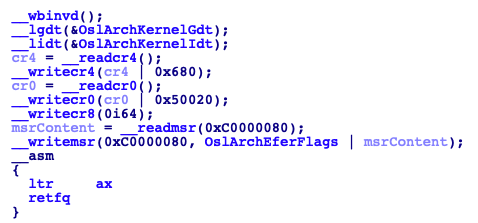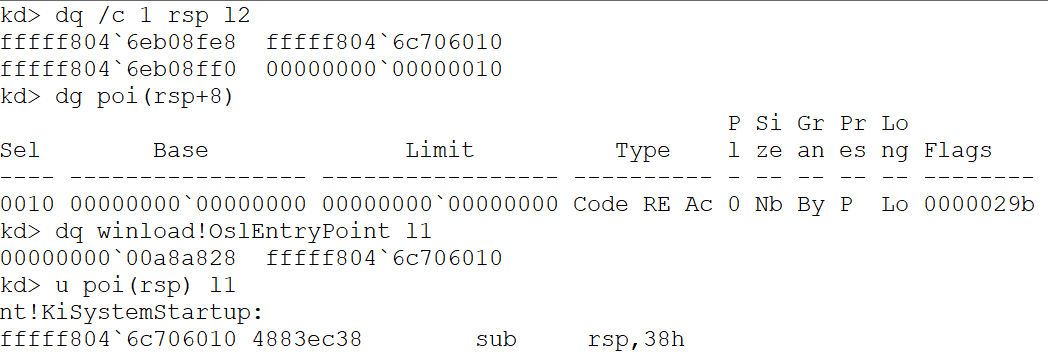Transition from an EFI Bootloader to the Kernel in Windows x64
In my previous post I explained how the Bootloader loads the essential Drivers so the Kernel can run. On that post I mentioned how the Bootloader has two main tasks. First task is to load the OS into memory and the second task is to manage the transition from the Bootloader to this recently loaded OS. I roughly explained first task. And I thought it could be interesting to give a little overview on how the second task is done. So, here we go!
This task is done by the function OslExecuteTransition, specifically OslArchTransferToKernel. In the following image you can see the decompiled code of this function:

First instruction basically stands for Write back and Invalidate Cache and basically writes back modified cache lines to main memory and invalidates the internals caches. Next, the corresponding values are assigned to the GDTR(lgdt) and the IDTR(lidt), then the following bits from CR4 are set:
- Bit 7: Page Global Enabled
- Bit 9: OSFXSR
- Bit 10: OSXMMEXCPT
The same is done with the following bits of CR0:
- Bit 5: Numeric error
- Bit 16: Write protect
- Bit 18: Alignment mask
and the bits 0 (System call Extensions) and 8 (Long Mode Enable) from the EFER(This value is obtained reading the MSR 0xC0000080). Being in a x64 machine we have the new CR8 which prioritize external interrupts, this value is set to zero which means no external interruptions will be prioritized. Lastly the selector pointed by TSS to the register TR, and after this everything is ready to execute the far return (Previously the EIP of the kernel and the Segment Selector of type Code and CPL 0 have been pushed to the stack).
The far return takes the IP and the CS from the stack, that’s why those values where pushed into it. The instruction
retfqis used instead of the instructionretfbecause the Bootloader runs in Long Mode, this means that each entry in the stack is 64 bits long, so in order to retrieve the IP and the CS from the stack it needs to read 64 bits not 32 bits.

As indicated in the Chapter 7 of the UEFI Specification v2.8, if the load of the OS was successful then the UEFI Loader can call the function ExitBootService which frees all the EFI Drivers of type EFI_IMAGE_SUBSYSTEM_EFI_BOOT_SERVICE_DRIVER, if this call returns EFI_SUCCESS then the UEFI Loader owns all available memory in the system and is also responsible for system execution to continue. The EFI Drivers of type EFI_IMAGE_SUBSYSTEM_EFI_RUNTIME_DRIVER are kept in memory and can be used with paging and virtual addresses as long as the service has described all the virtual space it will use by calling to the function SetVirtualAddressMap. Having in mind that Winload.efi is a UEFI Loader, logically it has to take charge of everything I just said. And it does! Inside the function OslExecuteTransition the first function getting called is OslFwpKernelSetupPhase1 which is in charge of doing what I explained previoulsy. This function only receive one parameter (The LOADER_PARAMETER_BLOCK)

this function also sets does the mapping of the physical to the virtual addresses, as explained before, calling SetVirtualAddressMap. (NOTE: The member EfiInformation seen in the following picture doesn’t have that name, corresponds to the last member of the structure _FIRMWARE_INFORMATION_LOADER_BLOCK and in the symbols it shows as u. I coined that name because it contains the structure _EFI_FIRMWARE_INFORMATION)

Curious fact: Quarkslab presented a POC of a Bootkit in 2013, Dreamboot which relies on hooking the function
OslArchTransferToKernel. At this point, in memory we can find all the structures the kernel needs to work by itself, so clearly is a good moment to have a “hook”More info on their paper (French) https://www.sstic.org/media/SSTIC2013/SSTIC-actes/dreamboot_et_uefi/SSTIC2013-Article-dreamboot_et_uefi-kaczmarek.pdf
Conclusions
This is a big overview, I skipped a lot of stuff that’s going on inside OslFwpKernelSetupPhase1 I just wanted to explain in a “simple” way how this goes and the role UEFI plays in all this. On the other hand, I still need to read the book Rootkits and Bootkits by Alex Matrosov, Eugene Rodionov, and Sergey Bratus, but I’m pretty sure they explain all this much better and detailed, so I believe it should be a good read for everyone interested on this topic (Also the UEFI Specification is an incredible source of knowledge). As always, I hope you enjoyed and feel free to contact me to discuss more or if there’s any mistake